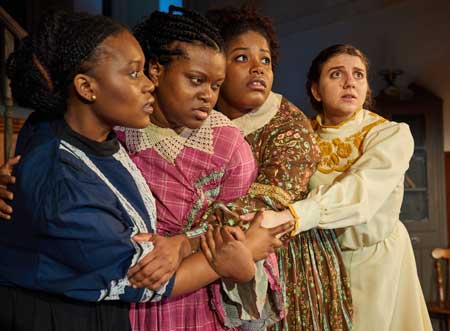Play (2018)
by Stefan Lanfer
Inspired by the historical research of Beth Miller
Directed by Pascale Florestal
Open Theatre Project
St. John’s Church
Jamaica Plain, Boston
February 9-24, 2018
With Christa Brown (Julia Williams), Caitlin Gjerdrum (Prudence Crandall), Regine Vitale (Hope Williams), Kevin Paquette (William Lloyd Garrison), Mary O’Donnell (Eleanor Dennison), Tenneh Sillah (Sarah Harris), Jon Vellante (Andrew T. Judson), Shana Jackson (Eliza Hammond)

Shana Jackson as Eliza Hammand
Christa Brown as Julia Williams
Caitlin Gjerdrum as Prudence Crandall
in “An Education in Prudence”
Photo: Matt McKee Photography
Courtesy of Open Theatre Project
Prudence Crandall (Caitlin Gjerdrum), the white Quaker headmistress of a girls’ school in Canterbury, Connecticut, is faced with the prospect of admitting a young African-American woman, Sarah Harris (Tenneh Sillah), to her school. She hesitates, and, with some trepidation about the local laws and public response, she decides to admit Harris. Following soon upon that, Crandall decides to admit another African-American, Julia Williams (Christa Brown), and then finally admits, in total, two dozen young African-American women. The response is brutal. The school is attacked, the girls are tormented and browbeaten, and Crandall is threatened with a lawsuit.
This inspiring but difficult story is, in Stefan Lanfer’s moving new play receiving its world premiere in this production by the Open Theatre Project, contextualized dramatically. The events described above are portrayed as occurring in a play within a surrounding play which is set in the present in a museum in Connecticut which commemorates this historic early attempt towards school desegregation. The tour guide at the museum, Eleanor Dennison (Mary O’Donnell), enlists the museum visitors to take part in a drama that enacts the admission of the young women and exhibits the conflicts and the legal engagements that occur as a result.
The story itself is deeply moving. The challenges these girls and their headmistress face from the local populace and authorities is, to say the least, unsettling. A grisly account of a near rape in which a gang accosts one of the young women and throws her off a bridge into a river exemplifies that daunting response of the populace.
William Lloyd Garrison (Kevin Paquette), the famous Boston abolitionist, offers considerable moral support to Crandall in her attempt to bring racial justice to her small school.
Apart from Crandall and Garrison, other unnamed whites, notably the man who jumps off the bridge to save the almost-drowned girl, provide some spark of justice in the midst of the racist onslaught.
The contextual story set in the present day features a young African-American college student (Christa Brown) who is angry and fiercely suspicious of any attempt to whitewash the long history of racial violence and prejudice by romanticizing the story of a school mistress who attempted to buck the system. Her mother (Regine Vitale) encourages her to take a second look and reconsider her way of responding to the events celebrated in the museum. This tension provides texture to the outer story and gives a sense of how one might appropriate the historic story in the present day.
The acting is very good overall, and the ensemble works very well together.
As the mother of the angry girl in the present day scene, and as Hope Williams, the mother of Julia, her analogue in the historic scene, Regine Vitale offers a notably strong and compelling account. Jon Vellante, as the local jurist who opposes the inclusion of the African-American girls, is slitheringly distinctive and effectively creepy. As Prudence, Caitlin Gjerdrum offers a solid and heartfelt anchor.
As the kookily energetic tour guide, Mary O’Donnell provides plenty of solid amusement. Playing the African-American girls, Christa Brown, Tenneh Sillah and Shana Jackson effectively represent the courageous dignity of their characters while dramatically conveying their outrages and fears. As William Lloyd Garrison, Kevin Paquette is rousing and earnest.
In the talkback after the show – being offered after the Saturday afternoon performances during the run – Boston public school alumnus and now teacher, Francis Pina, in a session entitled Race, Equity, and Opportunity in the Classroom offered an honest yet inspiring set of reflections on the possibility for school reform in the contemporary scene.
Lanfer’s play is interestingly conceived and attempts to deal honestly with contemporary perspectives as well as dramatizing the historic events at its heart. The ploy of having the museum visitors play the historic characters provides an inventive attempt to weave the two contexts together. Though the method becomes an effective way to give an account of what eventually happens to the school, it does push against one’s capacity to believe that museum visitors could embody the richness of the characters they are meant to portray. And though meant to help put into perspective the responses of the angry young African-American who is hearing the story, the end of the play moves a bit more quickly and with less focus than it might.
Overall, however, the force of the underlying theme is powerfully embodied, making for an intimate and moving account of a difficult but inspiring chapter in the history of education and racial relations in New England.
– BADMan
Leave a Reply